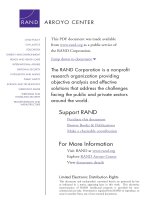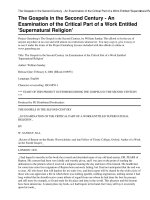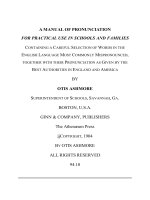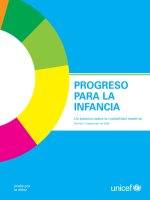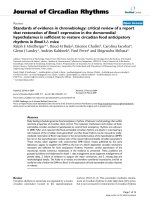CRITICAL THINKING IN CLASSROOMS
Bạn đang xem bản rút gọn của tài liệu. Xem và tải ngay bản đầy đủ của tài liệu tại đây (166.7 KB, 11 trang )
CRITICAL THINKING IN CLASSROOMS
Dinh Thi Lich
International Studies Department
College of Foreign Languages
I. INTRODUCTION
Becoming a student of a university is the first big move in a learner’s life. It
also brings to them great changes and challenges as they begin a quite new
environment of education as well as of living that is affected by different factors.
However, entering a college does not mean that all students are successful in the
new educative environment. It bases on not only instructors or knowledge from
documents. It also depends on the ability to think and how to acquire knowledge
of learners - students. In a class, acquiring knowledge is not merely listening,
looking, and writing. We ourselves need to own the private thinking and ideas on
everything and contact with others. Especially, in an increasingly changing world,
critical thinking ability has become a crucial attribute that is expected of university
students. However, critical thinking is also difficult skills and it is affected by
many factors such as culture, society, personality, habits, and learning
environment. The differences of these factors especially are of culture will cause
cross-cultural matters that influence on teaching and learning task.
II. CRITICAL THINKING IN CLASSROOMS
1. What is critical thinking?
“Critical thinking is a pervasive academic literature term that is seldom
clearly or comprehensively defined” (Ken Petress, 2011). In the academic
environment like university, we often hear the term “critical thinking” but we even
understand it not clearly. In my opinion, critical thinking is what required the most
by students for their works in the university as well as for the other aspects in their
life. So what is critical thinking.
According to Scriven and Paul (2003):
"Critical thinking is the intellectually disciplined process of actively
and skillfully conceptualising, applying, analysing, synthesising and/or
evaluating information gathered from, or generalised by, observation,
experience, reflection, reasoning or communication, as a guide to belief or
action In its exemplary form, it is based on universal intellectual values that
transcend subject matter divisions: clarity, accuracy, precision, consistency,
relevance, sound evidence, good reasons, depth, breadth, and fairness."
(Scriven & Paul, 2001, p.1).
This definition is full with involving many different factors that influence on our
ability to critically think but it is also quite complex to be able to understand
clearly.
One definition of critical thinking is of Edward Glaser in 1941. He defined
critical thinking that
“The ability to think critically, as conceived in this volume, involves
three things: ( 1 ) an attitude of being disposed to consider in a thoughtful
way the problems and subjects that come within the range of one's
experiences, (2) knowledge of the methods of logical inquiry and reasoning,
and (3) some skill in applying those methods”. (Glaser, 1941).
Critical thinking requires us a thoughtful attitude in considering any matter.
Besides, experience and skills are also necessary that can help us have ability of
critical thinking in our life, which will support our knowledge and creation.
"Critical Thinking means that the critical person has not only the capacity (the
skills) to seek reasons, truth, and evidence, but also that he or she has the drive
(disposition) to seek them”. (Burbules and Berk, 1999)
In general, critical thinking is the process of actively applying intelligence
and all our skills we have to analyze, synthesize and evaluate the works, ideas, and
theories as well as to make judgments on other things, make decisions, and form
the individual behavior of us.
2. Critical thinking in classrooms
The same with critical thinking in any context of life, critical thinking in
classrooms also involves a variety of skills that can help students improve their
classroom performance such as "understanding the arguments and views of others;
critically evaluating those arguments and views; developing and defending one's
own well-supported arguments and views". (Bassham et al., 2002, p.9)
Although critical thinking is so difficult, it is important and need to be
broadened in classrooms. Debra J. and Paul N. have made a survey of faculty at 38
public and 28 private California universities about critical thinking of students.
Their survey has showed that:
"Nearly 90% of respondents claimed that critical thinking constituted a
primary objective of their teaching. Yet, only a small minority (9%) clearly
taught critical thinking skills on any given day. The first statistic shows just
how important critical thinking is in the eyes of instructors, but the second
indicates that you must acquire those vital skills before you get to the
discipline-based courses."(Jackson, Newberry, 2010, p.3).
Obliviously, when students learn the higher levels they are required to be
self-educated more than. Instead of acquiring passively knowledge from teachers
and books, they themselves have to study, make choices and decisions for
everything. So critical thinking is a meaningful tool. "Critical thinking can be used
to foster student learning in many courses, such as science and English, and thus
can be an element that helps tie the students’ education together in a way that
encourages the transfer of knowledge." (Dr. Davis, 2011)
According to Rudd, "critical thinking involves skills that students can best
learn through a teacher's effective instructional practices". (Rudd, 2007, p. 46-49)
In a classroom, all students and instructor share together a climate, in fact,
is their responsibility to make a quality class. The author Bell Hooks expressed
that “Feminist thinking in the classroom brought an energy of opposition and
dialectical exchange to the forefront in higher education”. (Hooks, 2009, p.94).
When teacher give an issue, each student is completely be able to evaluate,
analyze, and express his or her own ideas on it. Besides, “students have open
discussions with each other, and learn not only each other’s ideas, but each other’s
ways of thinking” (Crawford, Saul, Mathews, & Makinster, 2005 , p.7)
"In college you are expected not only to learn more advanced material than
you learn in high school, but also to do things with that material that are more
cognitively sophisticated and demanding than has been expected of you up to this
point." (Jackson, Newberry, 2010, p.3). That is right. Although all basic
information are very important knowledge, in college, we need to "go far beyond
these basics both in content and in what you are asked to do with the information
you learn" (Jackson, Newberry, 2010, p.3). Critical thinking creates thinking
interaction between students and teacher as well as between students to each other
and thus helps to narrow the gap in classrooms. Moreover, when we look at a
class, "the level of students' cognitive development plays a large part in
determining how well they understand, learn, and later use critical thinking
concepts". (Dunn, Halonen, & Smith, 2008, p.3).
In the short words, critical thinking plays an important role in classrooms. It
is the aim that education system trying to carry out. Objective criticism will help
students have a positive look to avoid the negative things and to tend the new
things which are better, more perfect and more useful.
However, critical thinking has to face with many complex barriers.
Bassham G. and his colleagues (2002) has had a list of the most common barriers
to critical thinking including: lack of relevant background information; poor
reading skills; bias; prejudice; superstition; egocentrism (sefl-centered thinking) ;
sociocentrism (group-center thinking); peer pressure; conformism; provincialism;
narrowmindedness; closemindedness, unwarranted assumptions, wishful thinking;
and many other things else. In that, four factors "play an especially powerful role
in hindering critical thinking" (Bassham et al., 2002, p.9) are egocentrism,
sociocentrism, unwarranted assumptions, and wishful thinking. Beside, there is
another powerful barrier to critical thinking of students is relativistic thinking
including subjectivism and cultural relativism. (Zaid A. Alsagoff, 2007).
Moreover, culture and habit are the factors that strongly influence to critical
thinking ability.
3. Differences of critical thinking between Vietnamese students and
American students.
According to the definitions and the barriers of critical thinking, we can
find that sociocultural factor strongly influences on it. To prove for this, basing on
studies of many authors as well as observation from means of communication, I
would like to make a comparison on critical thinking of students between two
completely different cultures. They are a Vietnamese class – presents for the East
culture- and an American class – the West culture.
Vietnamese students
American students
- Reproductive rote learning is popular
- Analytical and speculative learning is
- Passive reception of information
- Always try to learning all information
given
- Activities of summarizing, identifying,
describing and applying formulas and
information
-Seldom challenge or question the
teacher.Characteristic question is What?
- Reading resource usually limited to
one text and teacher notes
- Circular pattern of thinking and
reasoning.
- Less inclined to seek assistance and
clarification in learning process.
- Students play role of listeners and the
recipient of written notes in class
expected
- Critical reception of information in all
subjects
- Selective learning of key concepts and
details
- Activities of questioning, judging,
recombining ideas and information into
an argument.
- Always ask Why? How? How valid?
How important? or What if?
- Reading is widely
- Logical linear patterns of thinking and
development of logical arguments and
opinions
- Seek assistance as part of learning
process.
- Students play role of listeners in class
but taking own notes simultaneously.
Only limited notes, they are provided
the handouts.
- Limited using eye contact with teacher
- Enjoy keeping silent in classrooms
- Tend to be afraid to voice their
opinions and to interact with others
- Use eye contact when speaking and
listening
- Be active in learning style
- Make questions during class time
(Mezaer, 1992, pp. 157-161)
Vietnamese and American belong to two completely different cultures
while culture has powerful influence on the personality and thinking of people. In
the Eastern culture, people would like to get a peaceful life, quiet space. They tend
to collectivism so always wish to keep the relations the best. Meanwhile, Western
culture is completely different. People are independence and active. They belong
to the individualism and always express their own thinking by speeches. In other
words, critical thinking ability of students is affected strongly by sociocultural
factor.
III. CONCLUSION
Obliviously, critical thinking is important skills in the classrooms, and in
general life. It promotes people's brain develop and helps people be objective in
every context. For students, critical thinking is always a set of necessary skills as
well as the aim that they catch.
"Critical thinking requires a strange blend of humility and confidence"
(Wiggins, 2011). We all must overcome the natural human instinct to defend
anything they believe. And student, like everyone else, can be wrong, and they
must be prepared to humbly face and admit it when they are. The power of critical
thinking is that it produces a self-reliant mind which is capable of great feats.
Instead of blindly accepting the conclusions of others, everyone will ask for the
data and come up with your own conclusion. (Wiggins, 2011).
In my opinion, students need to understand clearly about critical thinking
and its barriers to adapt or to get good critical thinking ability. Besides, teachers
also need to understand the role of culture in the critical thinking ability of
students to have appropriate teaching methods and to help students overcome the
psychological barriers that are marked by cultural learning process.
REFERENCES
1. Alsagoff, Z. A. (2007). Introduction to critical thinking. Retrieved
December 10, 2011 from />critical-thinking
2. Bassham, G., Irwin, W., Nardone, H. & Wallace. J. M. (2002). Critical
thinking - A student's Introduction, p.9
3. Bassham, G., Irwin, W., Nardone, H. & Wallace. J. M. (2002). Critical
thinking - A student's Introduction, p.11-24
4. Burbules, C. N. & Berk, R. (1999). Critical Thinking and Critical
Pedagogy: Relations, Differences, and Limits
5. Crawford, A., Saul, E. W., Mathews, S., & Makinster, J. (2005). Teaching
and learning strategies for the thinking classroom, p.7
6. Dr Davis. (2011). Critical Thinking: Importance in the Classroom.
Retrieved December 10, 2011 from chingcollegeenglish.
com/2011/02/24/critical-thinking-importance-in-the-classroom/
7. Dunn, D. S., Halonen, J. S., & Smith, R. A. (2008). Teaching critical
thinking in psychology- A handbook of best practices, p.3
8. Gamble, T. K. & Gamble, M. W. (1998). Contacts Communicating
Interpersonally
9. Glaser, E. M. (1941). An Experiment in the Development of Critical
Thinking
10. Hooks, B. (2009). Teaching critical thinking: practical wisdom, p.94
11. Jackson, D. & Newberry, P. (2010). Critical thinking – a user’s manual,
p.3
12. Mezaer, J. (1992). Bridging the Intercultural Communication Gap. TAFE
International, pp. 157-161
13. Myers, D. G. (2003). Exploring Psychology, 5th ed. New York: Worth, xv,
pp. 11
14. Parker, R. & Moore, B. N. (2003). Critical thinking
15. Petress, K. (2004). Critical thinking: an extended definition. Retrieved
December 18, 2011 from
/>e/06_CT_Extended_Definition.pdf
16. Rudd, R. (2007). Defining critical thinking. Techniques, p. 46-49
17. Scriven, M., Paul, R. (2001). Defining Critical Thinking , p.1
18. Scriven, M., Paul, R. (2003). Defining Critical Thinking. Retrieved
December 7, 2011 from
ning.html
19. Wiggins, A. (2011). Critical Thinking, Retrieved December 15, 2011 from

